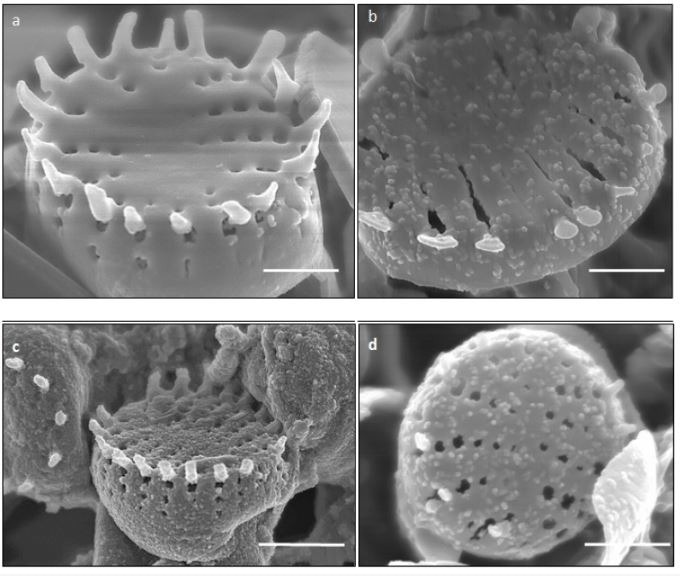Professor Andrzej Witkowski and his colleagues at the Institute of Marine and Environmental Sciences, University of Szczecin, have investigated Pseudostaurosira trainorii mediated biosynthesized iron-oxide nanoparticles (IONPs) to enhance laser desorption/ionization mass spectrometry (LDI-MS). Their findings have been published in The International Journal of Molecular Sciences.

SEM images showing surface morphology of control (a) and IONPs loaded (b–d) frustules P. trainorii [scale bar 1 μm]. Study: Study on Biogenic Spindle-Shaped Iron-Oxide Nanoparticles by Pseudostaurosira trainorii in Field of Laser Desorption/Ionization Applications. Image Credit: Roychoudhury, P. et al.
Properties of IONPs
Due to their superparamagnetic characteristics and prospective biomedical uses brought on by their biocompatibility and non-toxicity, IONPs have garnered great attention.
The quality of conventional IONPs in size, tuneability, monodispersity, and crystalline structure has greatly increased due to recent advancements in manufacturing IONPs. Specifically, by thermal breakdown of iron carboxylate salts.
Developing IONPs-based applications is made possible by improving the quality of both organic and water-soluble IONPs. Some examples are:
- Serving as drug delivery vehicles for precise drug delivery
- During magnetic resonance imaging as contrast agents
- As active agents in cancer therapies based on hyperthermia
- For use as magnetic detectors in in vitro testing
- As a nanoadjuvant for the generation of vaccines and antibodies
- As a source of genes for gene therapy
Methods for Producing IONPs
Thermal decomposition, microemulsion, co-precipitation, and colloidal processing are the most used methods for producing IONPs. However, these techniques do not produce IONPs in an environmentally acceptable manner and call for the use of dangerous compounds such as sodium borohydrate. Even though IONPs are considered entirely safe for biological systems, their use in medical applications is constrained due to the use of such harmful compounds in synthetic manufacturing methods.
For the creation of biocompatible IONPs, biogenesis has gained in popularity. A particular form of biocompatible IONPs - silica conjugated metal nanoparticles - uses techniques inspired by diatoms. It is sometimes necessary to dope metal particles onto a layer of silica to increase stability, hardness, and catalytic efficiency. For example, using the natural siliceous shells of bio-materials, specific metal nanoparticles, including gold, silver, platinum, titanium, germanium, and palladium, have been successfully doped.
For the first time, Prof. Witkowski’s team has proposed a bio-protocol for creating Pseudostaurosira trainorii (P. trainorii) doped, nanospindle-shaped IONPs.
The term "nanospindle" refers to a prominent subcategory of numerous nanoforms. It describes nanoparticles with a broad central region with both ends tapering in size ranges between 1-100 nm in any dimension.
Due to their greater efficiency in photothermal therapy, spindle-shaped particles are becoming increasingly popular. Spindle-shaped particles are also conducive to greater accumulation at tumor locations that could be employed for cancer detection.
Experimental Details
The various chemicals and the commercial sources from where they were procured for the experiments are detailed in the journal article.
Cultivation of the diatom was initiated with a pure culture of P. trainorii. This is activated from a chosen diatom strain.
Artificial saltwater in typical 7 ppt form was used to maintain the culture at 20 degrees Celsius and illuminated with a white light source with carefully chosen energy density.
The culture was exposed for half a day and covered for the rest. To get healthy developing biomass from the exponential growth phase, the strain was grown for 14 days.
For the creation of biogenic spindle-shaped IONPs, the entire biomass of the diatom strain P. trainorii was utilized as a reducing agent. After preparation, the entire experiment was kept at ambient temperature in the dark for three days to ensure the biofabrication was attained.
The golden yellow-tinted biomass that resulted from the reaction was collected after three days using centrifuging. Subsequently, iterative rinsing is performed on the obtained biomass to achieve purification of the diatom-based biosynthesized IONPs.
Acquiring light microscopic images, associated morphological variations in P. trainorii before and after 3 days of reaction with Fe3+ solution were recorded.
An axiscope was used to monitor the changes in fluorescence characteristics in NPs-loaded cells. Scanning electron microscope images of the control and Fe3+ treated P. trainorii were taken to document the surface topography.
Microscopic analysis of P. trainorii with energy dispersive X-ray spectroscopy and elemental mapping corroborated the deposit of IONPs on the surface of the frustules.
A series of techniques were used to characterize the frustule and the biogenic IONPs and analyze the laser desorption ionization. Fourier transform infrared spectroscopy and UV-Vis spectroscopy were employed for IONPs characterization, while inductively coupled plasma mass spectrometry, zeta potential, and X-ray diffraction were used for laser desorption ionization analysis, respectively.
Results and Outlook
When used as an inorganic matrix in laser desorption/ionization mass spectrometry, the biogenic IONPs demonstrated remarkable sensitivity to small compounds such as glucose, alanine, and triacylglycerols at nano- and picomolar level per spot, respectively.
The nanobiotechnology manufacturing of spindle-shaped IONPs that can be used in the future for the preparation of nanostructures-assisted laser desorption/ionization plates opens up new possibilities with the help of the biocompatible technique that Prof. Witkowski’s group has shown.
References
Roychoudhury, Piya, Aleksandra Golubeva, Przemysław Dąbek, Oleksandra Pryshchepa, Gulyaim Sagandykova, Paweł Pomastowski, Michał Gloc, Renata Dobrucka, Krzysztof Kurzydłowski, Bogusław Buszewski, and Andrzej Witkowski. (2022) Study on Biogenic Spindle-Shaped Iron-Oxide Nanoparticles by Pseudostaurosira trainorii in Field of Laser Desorption/Ionization Applications. International Journal of Molecular Sciences 23, no. 19: 11713. https://www.mdpi.com/1422-0067/23/19/11713/htm
Disclaimer: The views expressed here are those of the author expressed in their private capacity and do not necessarily represent the views of AZoM.com Limited T/A AZoNetwork the owner and operator of this website. This disclaimer forms part of the Terms and conditions of use of this website.